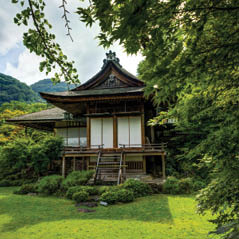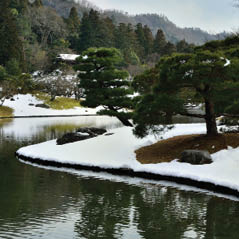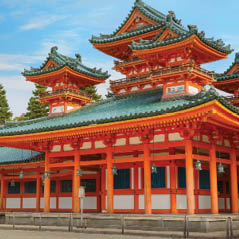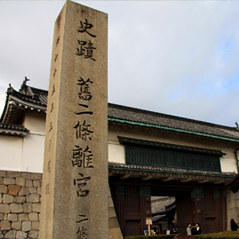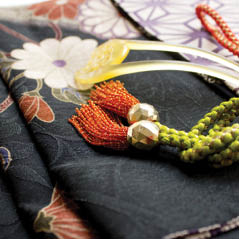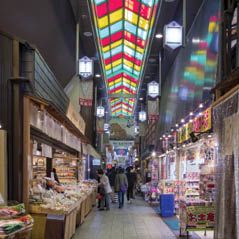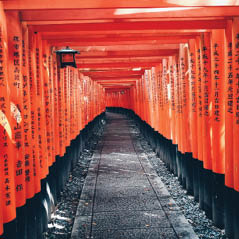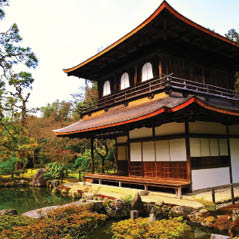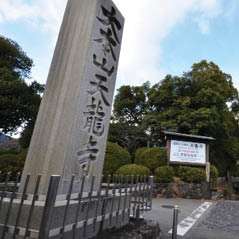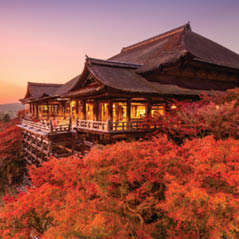Why visit Kyoto
Historic Buildings
Voyage into Japan’s yesteryear and visit Kyoto’s array of historic buildings. The city has an impressive collection of UNESCO World Heritage sites, and continues to be an alluring destination for those interested in learning about Japan’s illustrious past. Step back in time to the era when samurai walked the earth and take a tour of these must-see spots in Kyoto.
Ōkōchi Sansō
Located in the foothills of Mt. Ogura at the end of the winding bamboo forests of Arashiyama, you’ll find this former home and garden of the Japanese period film actor, Denjirō Ōkōchi. This sublime abode provides one of the finest examples of traditional Japanese residential architecture, and the sprawling gardens offer unprecedented views out over the city.
Shūgaku-in Rikyū Imperial Villa
Originally constructed as a luxury summer vacation home for the Imperial family, the Shūgaku-in Rikyū Imperial Villa is a sight to behold. The villa’s grounds are divided into three elaborate garden areas, each with their own unique tea-ceremony house. Our local guide recommends heading to the upper garden to see surrounding views of the picturesque Kyoto hills.
Heian-jingū Shrine
A scaled-down reproduction of the original Imperial Palace (Daigoku-den), the Heian-jingū Shrine is a richly-coloured set of beautiful religious buildings. Consider spending time in the large gardens which are found in the North, South, East, and West of the shrine. Though it is a more recent addition to Kyoto’s sacred spots, it is worth your time to visit this historic site.
Nijō-jō Castle
Visit this elaborate castle in downtown Kyoto and discover where the powerful Tokugawa Shoguns once resided. Walk through sliding paper doors to see elaborate woodcarvings and intricate works of Japanese art. After you tour the interior, we suggest you head to the courtyard where you’ll find the picturesque Ninomaru Garden designed by Kobori Enshu.
Cultural Attractions
Kyoto was the former Imperial capital of Japan for over one-thousand years. In fact, the word kyoto itself means “capital city.” While the legislature and emperor have since moved to Tokyo, the Japanese still think of Kyoto as a cultural, religious, and economic hub.
Kodai Yuzen-en Gallery
See a vast selection of colourful kimonos and learn about the ancient dyeing technique of Yuzen at the Kodai Yuzen-en Gallery. See the artful skill of the dyeing process as you watch artists deftly paint designs onto each kimono. Try your hand at this creative craft and receive a lesson in the art of stenciling.
Nishiki Market
Dive in to Kyoto’s traditional food scene and explore this culinary landmark. Nishiki Market features all the ingredients necessary for an authentic Kyoto meal, including fresh fish, Kyo-yasai (Kyoto vegetables), wagashi (Japanese sweets), and tea. Sample some yakitori (skewered meat) or just amble through this market for a true taste of Kyoto’s delicious culinary scene.
Kyoto Station
This transportation hub in Kyoto is also one of the city’s largest buildings. Unlike the historic, untouched temples, this futuristic structure features several shopping malls, multiple restaurants, and many hotels. We recommend checking out this modern architectural marvel while on tour.
Fushimi Inari Taisha
Embark on a tour of the most revered shrine of Inari, dedicated to the gods of rice and sake by the Hata family in the eighth century. Find yourself strolling under spectacular rows of orange torii (traditional Japanese gate) and follow the path it weaves through the forest to the inner shrine. Be sure to wear some comfortable walking shoes when visiting this site!
Buddhist Temples
There are over 1500 temples and shrines in Kyoto. These places of worship are must-sees when travelling through this ancient city. From tiny, unassuming temples to massive monuments, these are but a few highlights of Kyoto’s many Buddhist temples.
Ginkaku-ji
Found along Kyoto’s eastern mountains is this storied Buddhist temple. The Ginkaku-ji was originally constructed to serve as a place of respite and solitude for the Shogun. While it is referred to as “The Silver Pavilion,” you won’t find any silver décor here. This temple is a testament to Japan’s wabi-sabi (beautifully imperfect) elegance.
Tenryū-ji
Spanned by the scenic Togetsu-kyo, or “Rising Moon Bridge,” this Buddhist temple serves as the headquarters for the Tenryū branch of the Rinzai School of Zen Buddhism. The site has been ravaged by several fires but still retains its tranquil atmosphere thanks to gorgeous gardens and beautiful works of art. You may want to stop at the notable Zen vegetarian restaurant for a delicious lunch.
Kiyomizudera
Literally translated to “Pure Water Temple,” the Kiyomizudera Temple takes its name from the nearby pure, natural waters of the Otowa Waterfall. Ascend the hillside of the Higashiyama Ward of eastern Kyoto to reach this celebrated Buddhist site. We suggest seeking out the temple's primary object of worship¬¬–a statue of the eleven faced, thousand-armed Kannon, the goddess of mercy.
Tōfuku-ji
Classified as one of the Five Great Zen Temples in Kyoto, the Tofuku-ji is a large Zen temple founded in 1236 at the command of the powerful Fujiwara clan. The grounds contain multiple sub-temples and several gardens that showcase the evolution of the art of garden design in Japan. The site is particularly popular in autumn, when people come from all over Japan to see the turning of the temple’s maple trees.
